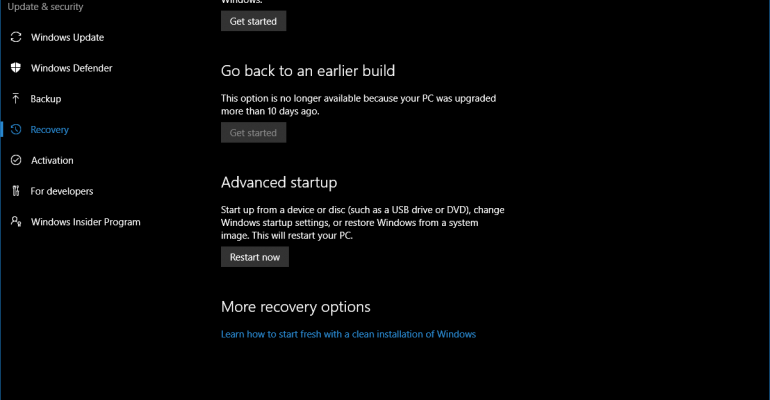Ever since Windows 10 started to offer users an opportunity to recover their system by rolling back an upgrade installation the window for that option was always 30 days.
This made a lot of sense during the first year with Windows 10 as Microsoft was offering Windows 7 and 8.1 users a free upgrade to Windows 10 and 3 to 4 weeks is a good period of time to check things out. If they were unhappy for whatever reason they had plenty of time to rollback to their previous version of Windows.
Of course, this recovery option was also available for Windows Insiders just in case they needed to back down from a new build to sort out any issues with the latest update.
Well, as I have been poking around the recently released Windows 10 Anniversary Update I noticed that this recovery option's timeframe has been changed to just 10 days.
Initially I thought my mind was playing tricks on me so I went to my other machines running Windows 10 Build 14393.10 and found they all showed the same 10 day rollback period with the exception of the VMs I had just upgraded to the Windows 10 Anniversary Update this week (also build 14393.10).
So I reached out to Microsoft to ask about this change because I had not seen anything online about it from them or any other tech sites around the Windows 10 Anniversary Update release.
According to a Microsoft spokesperson, it was a data driven decision to change this rollback timeframe from 30 to just 10 days:
"Based on our user research, we noticed most users who choose to go back to a previous version of Windows do it within the first several days. As such, we changed the setting to 10 days to free storage space used by previous copies."
We already know that Microsoft collects various levels of anonymous telemetry from Windows 10 systems because that information has been used in the past to make engineering decisions to eliminate certain features that are not widely used. That allows Microsoft to focus engineering efforts in other areas of the operating system that are being actively used.
In the same way this telemetry allowed Microsoft to see that most users were not waiting up to 30 days to rollback to their previous operating system after a Windows 10 upgrade but were making that move back in less than a week.
Whether that is a good or bad thing for Windows 10 is fodder for another discussion.
However, by adjusting this timeframe in the setting itself, Microsoft can now recover anywhere between 3 and 5GB of storage space on the users device that would normally be occupied by the previous operating system files that were saved for a possible rollback recovery.
That is a significant amount of space on the many low storage devices that are out there so this seems like a very logical use of telemetry and other data points to improve the overall functionality of a Windows 10 system.
What do you think of the change?
--------------------

Be sure to check out all of our Windows 10 Anniversary Update Coverage.
But, wait...there's probably more so be sure to follow me on Twitter and Google+.





